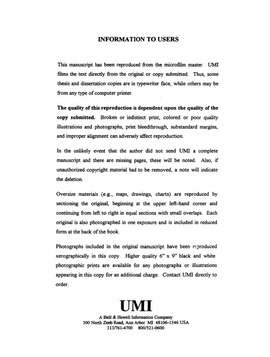| dc.contributor.advisor | Lomolino, Mark V., | en_US |
| dc.contributor.author | Channell, Robert B. | en_US |
| dc.date.accessioned | 2013-08-16T12:30:19Z | |
| dc.date.available | 2013-08-16T12:30:19Z | |
| dc.date.issued | 1998 | en_US |
| dc.identifier.uri | https://hdl.handle.net/11244/5713 | |
| dc.description.abstract | I examined the contraction of geographic ranges in 245 species. Remnant portions of the geographic range tended to persist in the periphery of the species' historical range. Larger patches of the geographic ranges persisted longer than smaller patches. For species that occurred on both the mainland and islands, islands maintained their populations better than the mainland. All of the continents except Africa, had significantly more species persist in the periphery than near the center of the species' historical range. While continental species had significantly more species persist in their historical periphery, insular species showed no such bias. I suggest that the observed patterns of range contraction may be the result of isolation from human disturbance. Patterns in the contraction of geographic ranges may be of value in building the conservation of sensitive species. | en_US |
| dc.description.abstract | The influence of different variables on the process of range contraction was investigated using spatial simulation modeling. Actual range contractions of species were also simulated using distributional data of introduced species thought to be responsible for the range declines. The shape of the species' historical range, initial distribution of the extinction factor, and the method of population loss dominated the simulated ranges contractions. These results suggest that the observed patterns of range contraction may be the result of interaction of many different factors. These simulations also highlight the need for appropriate data on the spread of extinction factors and their influence on susceptible populations. | en_US |
| dc.description.abstract | I then evaluated two hypotheses of range contraction by contrasting the predicted sequence of range contraction with empirical observations. While the demographic hypothesis suggests the demographic characteristics of the historical populations determine which populations persist, the contagion hypothesis states that the geographic dynamics of the extinction factors determine which populations survive. The results of Monte Carlo simulations and regression analysis were consistent with the contagion hypothesis. These results suggest that most range contraction should progress from the edge first impacted by the extinction factor, then the central portion of the range, and finally the periphery most distant from the initial impact of the extinction factor. | en_US |
| dc.format.extent | xii, 299 leaves : | en_US |
| dc.subject | Zoogeography. | en_US |
| dc.subject | Extinct animals. | en_US |
| dc.subject | Biology, Ecology. | en_US |
| dc.subject | Endangered species Geographical distribution. | en_US |
| dc.subject | Biology, Zoology. | en_US |
| dc.title | A geography of extinction: Patterns in the contraction of geographic ranges. | en_US |
| dc.type | Thesis | en_US |
| dc.thesis.degree | Ph.D. | en_US |
| dc.thesis.degreeDiscipline | Department of Biology | en_US |
| dc.note | Source: Dissertation Abstracts International, Volume: 59-09, Section: B, page: 4598. | en_US |
| dc.note | Adviser: Mark V. Lomolino. | en_US |
| ou.identifier | (UMI)AAI9905629 | en_US |
| ou.group | College of Arts and Sciences::Department of Biology | |
